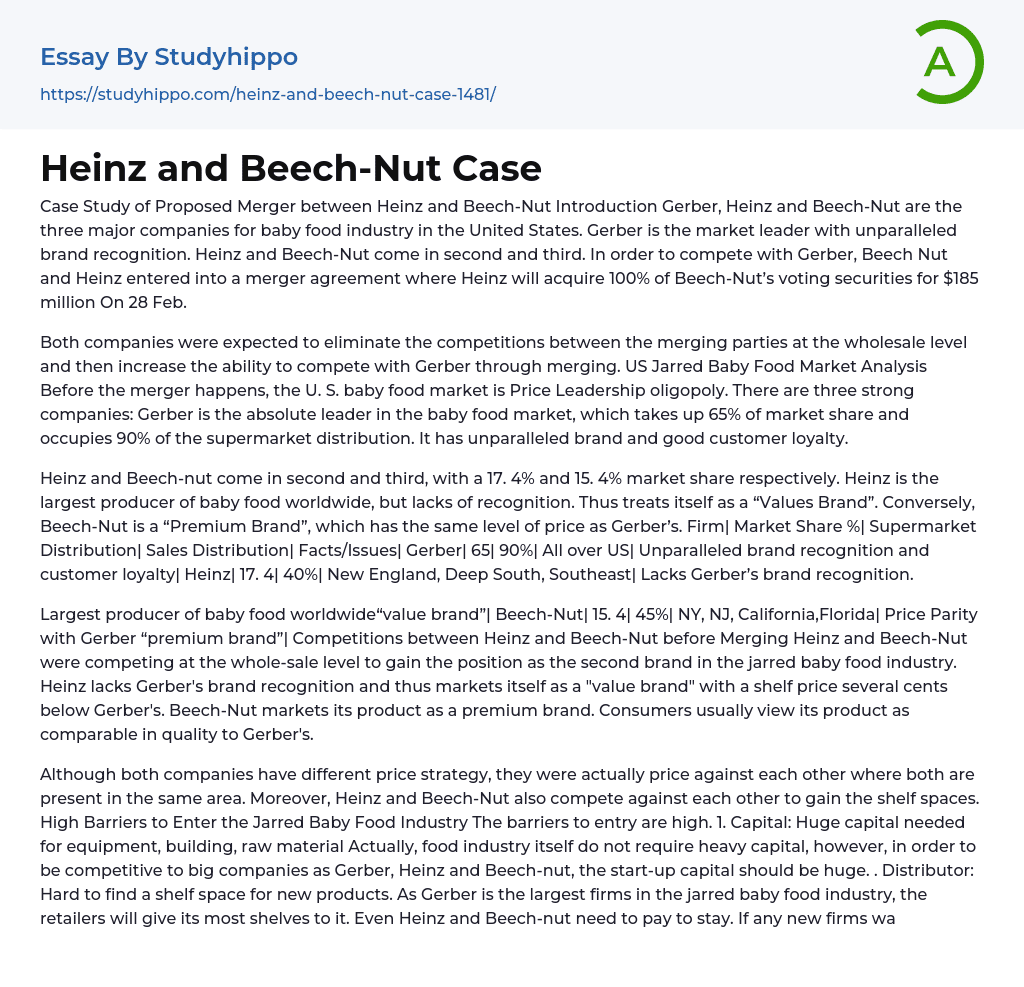Case Study of Proposed Merger between Heinz and Beech-Nut Introduction Gerber, Heinz and Beech-Nut are the three major companies for baby food industry in the United States. Gerber is the market leader with unparalleled brand recognition. Heinz and Beech-Nut come in second and third. In order to compete with Gerber, Beech Nut and Heinz entered into a merger agreement where Heinz will acquire 100% of Beech-Nut’s voting securities for $185 million On 28 Feb.
Both companies were expected to eliminate the competitions between the merging parties at the wholesale level and then increase the ability to compete with Gerber through merging. US Jarred Baby Food Market Analysis Before the merger happens, the U. S. baby food market is Price Leadership oligopoly. There are three strong companies: Gerber is the absolute leader in the baby food market, which takes up 65% of market share and occupies 90% of t
...he supermarket distribution. It has unparalleled brand and good customer loyalty.
Heinz and Beech-nut come in second and third, with a 17. 4% and 15. 4% market share respectively. Heinz is the largest producer of baby food worldwide, but lacks of recognition. Thus treats itself as a “Values Brand”. Conversely, Beech-Nut is a “Premium Brand”, which has the same level of price as Gerber’s. Firm| Market Share %| Supermarket Distribution| Sales Distribution| Facts/Issues| Gerber| 65| 90%| All over US| Unparalleled brand recognition and customer loyalty| Heinz| 17. 4| 40%| New England, Deep South, Southeast| Lacks Gerber’s brand recognition.
Largest producer of baby food worldwide“value brand”| Beech-Nut| 15. 4| 45%| NY, NJ, California,Florida| Price Parity with Gerber “premium brand”| Competitions between Heinz and Beech-Nut before Merging Heinz and Beech-Nut were competing a
the whole-sale level to gain the position as the second brand in the jarred baby food industry. Heinz lacks Gerber's brand recognition and thus markets itself as a "value brand" with a shelf price several cents below Gerber's. Beech-Nut markets its product as a premium brand. Consumers usually view its product as comparable in quality to Gerber's.
Although both companies have different price strategy, they were actually price against each other where both are present in the same area. Moreover, Heinz and Beech-Nut also compete against each other to gain the shelf spaces. High Barriers to Enter the Jarred Baby Food Industry The barriers to entry are high. 1. Capital: Huge capital needed for equipment, building, raw material Actually, food industry itself do not require heavy capital, however, in order to be competitive to big companies as Gerber, Heinz and Beech-nut, the start-up capital should be huge. . Distributor: Hard to find a shelf space for new products. As Gerber is the largest firms in the jarred baby food industry, the retailers will give its most shelves to it. Even Heinz and Beech-nut need to pay to stay. If any new firms want to entry this market, it will be really hard for it to find shelf position, if can, it will be extremely expensive. 3. Economy of scale: Large, experienced firms can generally produce goods at lower costs than small, inexperienced firms.
Gerber, Heinz and Beech-nut are the dominated three companies in the jarred baby food industry, they are large in scale, experienced in operating in this industry, they knows exactly how to produce goods at lower costs. Also they have large demands; a massive production
will also decrease the costs. New comers will not have those advantages. Thus, they will definitely lose in the price battle. That keeps those who want to entry this market out. 4. Customer loyalty: Gerber has the best customer loyalty in baby food industry.
The existing firms already have good reputation and customer loyalty to the products. The presence of established famous brands could be the high barrier in this case. Impact of Merger to Consumers The merging of Heinz and beech-Nut shifts the baby food industry from Price Leadership Oligopoly to Duopoly model. In order to maximize their profits, it is likely that Gerber and the company after merger will have a collusion to agree on the higher price. Consumers have no other choices thus can only accept. As a result of the reduced competition, the quality of the products will also be decreased.
Conclusion The merger is not necessary for Heinz and Beech-nut. Although the merger will bring both company some efficiency, such as reduce operating costs. The companies can’t achieve those “efficiencies” they were expecting to have due to the changing in the market structure. Firstly, the likely collusion will lead to high price and low quality of the products. Consumer benefits would be lost. Secondly, the distribution network will not be improved by the merger for Beech-nut. Finally, the recipes would not be improved by the merger as well.
- Wal-Mart essays
- Discover essays
- Advertisement essays
- Advertising essays
- Anheuser-busch essays
- Audience Theory essays
- Brand essays
- Brands essays
- Competitor Analysis essays
- Consumer essays
- Detergent essays
- Marketing Management essays
- Marketing Mix essays
- Marketing Plan essays
- Marketing Research essays
- Marketing Strategy essays
- New Product Development essays
- Point Of Sale essays
- Price essays
- Procurement essays
- Product essays
- Product Differentiation essays
- Product Placement essays
- Promotion essays
- Promotion And Marketing Communications essays
- Research Design essays
- Retailing essays
- Trademark essays
- Bankruptcy essays
- Earnings essays
- Premise essays
- S corporation essays
- Secretary essays
- Tata Group essays
- American Dream essays
- Barriers To Entry essays
- Capitalism essays
- Central Bank essays
- Compensation essays
- Consumerism essays
- Economic Development essays
- Economic Growth essays
- Economic Inequality essays
- Economic System essays
- Economy essays
- Employment essays
- Export essays
- Finance essays
- Free Trade essays
- Gross Domestic Product essays




